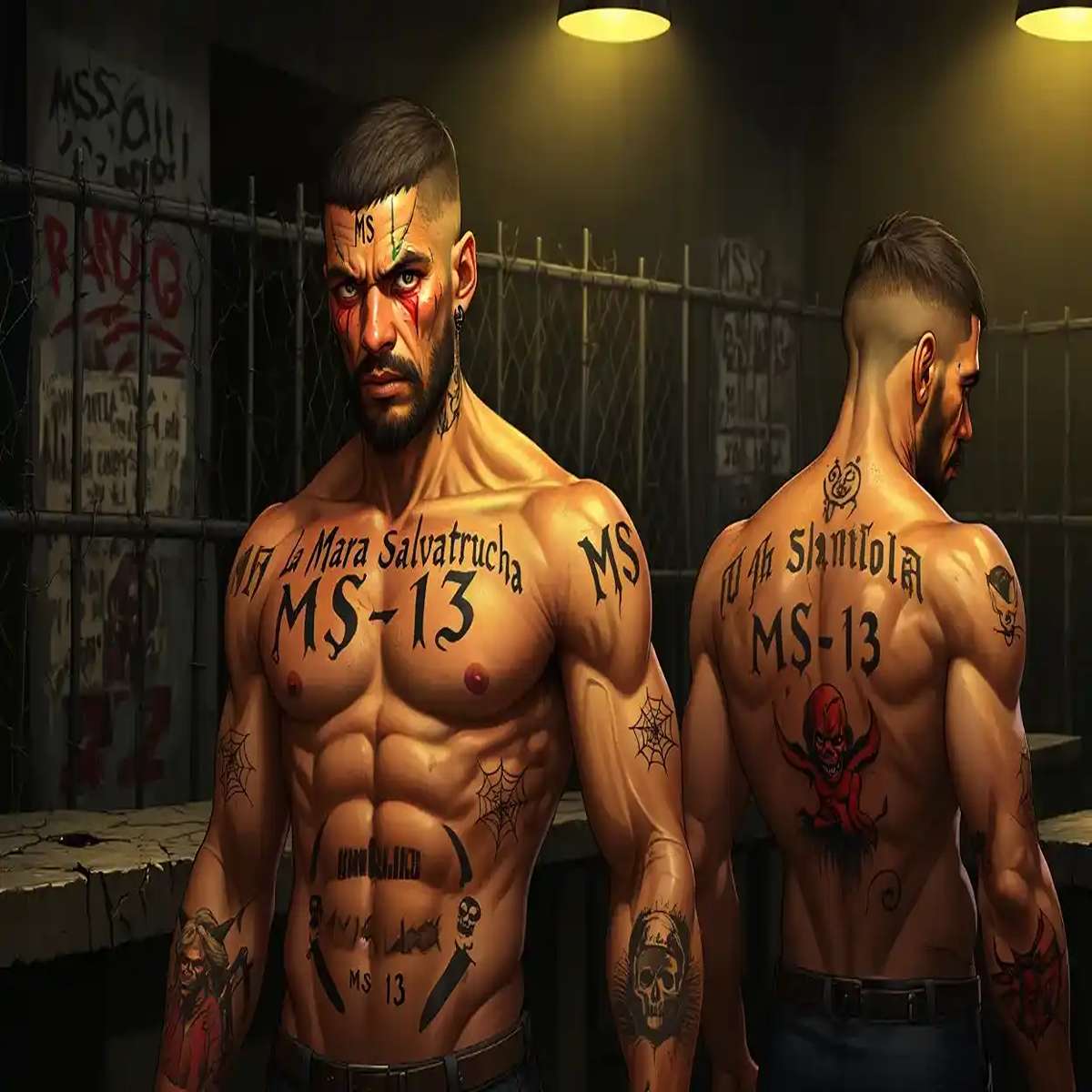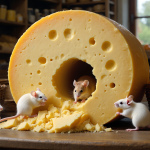MS-13 Tattoos and Meanings: The Devils Behind the Atrocities
April 29, 2025
Ink as a Vector: When Flesh Becomes a Flag of War
Ink isn’t just pigment—it’s a weapon. A vector. A force that rips through skin and identity alike. In the world of MS-13, tattoos are not artistic detours or rites of self-expression. They are branding irons of allegiance, scars of surrender, sigils of submission to a war machine. Every mark is a message carved into living flesh: You no longer belong to yourself.
These aren’t stories told voluntarily—they’re codes burned in under pressure, forged in prisons, barrios, and blood. Each curve of ink acts like a map of trauma, loyalty, and future violence. Tattoos here are coordinates in a psychological warzone—a haunting blend of personal history and collective dominance.
This isn’t body art. This is body ownership.
Sigils of Terror: MS-13’s Violent Language of Skin
Spider webs. Teardrops. “MS.” “13.” Devil horns. These are not mere motifs. They’re ritualised glyphs of warfare, dripping with dark semiotics. The number “13” isn’t edgy—it’s a sigil of fealty to the Mara. Devil horns? They signal total ideological surrender to an empire that devours its own.
Teardrops don’t mourn—they boast. Each one etched under an eye is a kill counter. Spider webs? Souvenirs of captivity, proof that you served time not just in prison, but in the unforgiving hierarchy of violence that rules from inside out.
Every symbol is a psychological landmine—both a badge and a trap. Once branded, you’re owned. You’re archived in the gang’s living blockchain—tracked, tested, and, if necessary, terminated.
Flesh as Territory, Skin as Surveillance
The tattooed body in MS-13 isn’t an individual—it’s occupied territory. Skin becomes a billboard of allegiance, constantly surveilled and policed by allies and enemies alike. A misspelling, a misplacement, a faded symbol? That can get you killed.
This is quantum identity collapse. The ink binds them—body to narrative, narrative to violence. Like entangled particles, one member’s pain is echoed across the collective. Their bodies function as walking contracts, each tattoo a binding clause. There’s no opt-out, no unsubscribe, only escalation or erasure.
Tattoos here don’t say “this is who I am.”
They say, “this is what owns me.”
Physics of Fear: Strange Attractors in Human Chaos
Gang tattoos resemble strange attractors in chaos theory—patterns emerging unpredictably from turbulent systems. MS-13’s tattoos are strange attractors in the chaos of violence, poverty, and marginalisation, drawing vulnerable youth into destructive orbits.
Like gravitational bodies warping spacetime, these tattoos warp the social fabric around them. Communities fracture as invisible boundaries form around tattooed bodies, creating no-go zones, territories of fear. The inked skin becomes a black hole, pulling in violence and repelling legitimate opportunities for integration, employment, or redemption.
This strange attractor effect explains the resilience of gang recruitment despite concerted efforts to intervene. Once bodies become marked, escape velocity becomes nearly impossible. The tattoos ensure that gang members remain trapped within hyper-violent orbits, unable to break free without catastrophic consequences.
Archetypes of Damnation: Tattoos of the Fallen Angel
The devil horns frequently tattooed by MS-13 members are no casual adornment—they invoke powerful archetypes. Lucifer, the fallen angel, embodies rebellion against divine order. Yet here, the uprising is twisted: instead of defying unjust authority, gang members defy societal norms that protect life and dignity. The archetype is inverted, perverted into a symbol of willing damnation rather than heroic defiance.
Gang members who tattoo these symbols onto themselves enact rituals of self-condemnation, accepting roles as fallen beings beyond redemption. The tattoos signify the corruption of the hero’s journey, transforming potential into tragedy and innocence into brutality. This perverse mythic resonance explains the tattoos’ enduring psychological potency, anchoring their bearers deeper into gang life and violence.
Economic Ink: Branding Humans as Assets
The dark economics behind these tattoos reveal a sinister logic. MS-13 operates as a violent economic enterprise—drug trafficking, human smuggling, extortion. Tattoos become branding marks, turning human beings into gang property. Each tattooed member is a living investment, marked as permanently affiliated, trusted to handle illicit profits and enforce violent debts.
The tattoos also ensure economic dependency. Visible facial or hand tattoos sabotage legitimate employment prospects, making gang activities the only viable economic path. This calculated economic coercion traps members in perpetual indebtedness, dependence, and exploitation, marked skin as collateral, and violence as currency.
MS-13 Tattoos and Meanings: Ink That Hijacks the Mind, Chains the Soul
MS-13 tattoos don’t just decorate the skin—they colonize it. From a cognitive science lens, these marks act as psychological anchors, rewiring identity with every etched line. They don’t symbolize loyalty—they program it. The gang doesn’t just live in their heads; it is their head.
Every new tattoo hardens the loop: trauma in, ideology out. These aren’t symbols—they’re scripts. Violence isn’t an act; it’s a role rehearsed daily. And once inked, escape doesn’t just mean leaving the gang—it means annihilating the self the ink created.
The tattoos whisper: You are this now. And the mind, brutalized by memory and groupthink, believes it.
Inked Like Gamblers, Bleeding for a Dream That Never Pays
Tattooed allegiance becomes a gambler’s paradox. Members double down on violence like traders chasing losses, bound by cognitive traps—loss aversion, sunk cost bias, ego death. Every new tattoo is another chip on the table, another “all in” on an identity they can’t afford but can’t walk away from.
The dream is seductive: respect, power, brotherhood. But it’s braided with delusion. Like market players clinging to a collapsing stock, gang members cling to the ink—believing the next act of brutality might finally validate the last.
But it never does. They bleed more, believe harder, die quicker.
Marked for Death, Hunted by Fate—But Some Still Run
And yet, some run.
Marked and hunted, a few fracture the algorithm. Despite the ink, despite the trauma, despite the system built to consume them, they get out. These aren’t flukes. They’re psychological edge cases that shatter the model.
They rewrite the meaning. Old symbols get re-coded, from death marks to redemption sigils. A teardrop becomes an apology. A devil horn becomes a scar of survival. These rare souls bend fate through resilience, timing, and unquantifiable defiance.
Their existence proves one thing: the ink isn’t the final word.
MS-13 Tattoos Flesh Maps of a Society That Let Them Burn
Zoom out. These tattoos aren’t just personal—they’re political.
Each mark reveals a societal equation: poverty plus trauma plus abandonment equals violence. The ink is the signature on a contract society signed and then ignored.
These bodies are maps—topographies of systemic neglect. They mark where institutions failed, schools collapsed, and prisons replaced parents. Every tattoo is a scream we’ve learned to ignore. But they don’t fade. They speak.
And what they say is this: the gang didn’t steal these people. We gave them away.
🔥 MS-13’s Most Heinous Atrocities – A Brutality Index Like No Other
From satanic executions to firebombed buses, this isn’t mere violence—it’s full-throttle psychological terror. Below, we map MS-13’s worst nightmares, ranked by brutality, symbolism, and psychological impact.
But ink is just the surface. Underneath lies an unbroken ledger of horror—real bodies, shattered communities, lives erased. This table isn’t shock porn; it’s a calibration of evil—a stark reckoning with MS-13’s legacy of brutality. The red stars mark the darkest ruptures in our shared humanity.
| Rank | Atrocity | Location & Year | Victims | ⭐ Rating | What Happened |
|---|---|---|---|---|---|
| 1 | Murder of Kayla Cuevas & Nisa Mickens | USA, Long Island (2016) | 2 teenage girls | ★★★★★ | Ambushed with bats and machetes. One victim’s face disfigured. Pure savagery as retribution theater. |
| 2 | Satanic Ritual Murder of 3 Women | El Salvador, 2015 | 8 women on a bus | ★★★★★ | Forced chanting, execution mid-transit. Economic brutality fused with spiritual sadism. |
| 3 | Mass Grave Discovery in La Libertad | Honduras, 2021 | 10+ bodies | ★★★★☆ | Women and minors found. Torture markings. Psychological decay evident in burial method. |
| 4 | Execution of Police Officer’s Family | Guatemala, 2019 | At least 3 victims | ★★★★☆ | Targeted for retaliation. Brutality extended to children. Message: resistance means extinction. |
| 5 | Torture of Rival Gang Members | El Salvador, 2019 | 1 young man | ★★★★★ | Beheaded, then displayed. This was not revenge. It was *branding.* |
| 6 | Torture of Pregnant Teen for Leaving Gang | El Salvador, 2019 | 1 young woman | ★★★★★ | Beaten, dismembered. Fetal remains used in ritual message. Loyalty demanded beyond life. |
| 7 | Firebombing of a Bus for Non-Payment | Mexico, 2022 | 28 people | ★★★★☆ | Extortion turned execution. Bus became coffin. Even children were burned alive. |
| 8 | Live-Streamed Torture and Execution | Mexico, 2021 | 2 rivals | ★★★☆☆ | Posted in real-time. Used to recruit teens through fear-stimulation. Comments section cheered. |
| 9 | Beheading of Local Mayor’s Aide | Honduras, 2020 | 1 victim | ★★★★☆ | Symbolic murder timed before elections. Terror as political leverage. |
| 10 | Mass Rape Initiation Ceremony | El Salvador, 2018 | Multiple teenage girls | ★★★★★ | Gang recruits participated. Filmed and used as “loyalty test.” Full-on nihilism ritualized. |
When brutality is the brand, atrocity becomes the message. This table isn’t just history—it’s a mirror of failed deterrence.
Conclusion: Ink-Stained Vectors, Blood-Soaked Loops, and the Monsters We Made
These tattoos aren’t rebellion. They’re recursive loops of trauma—a violent syntax inked into flesh, looping identity with ideology, desperation with dominion. Every symbol is a vector: pulling the wearer toward belonging, submission, annihilation. A spider web isn’t just ink—it’s a gravitational trap. The number 13 isn’t a badge—it’s a curse encoded into skin.
This isn’t art. It’s the architecture of fear, failure, and forgotten children reprogrammed into soldiers.
To understand this isn’t to romanticise the terror—it’s to accept the brutal coordinates of collapse. MS-13 is not a fluke. It’s the predictable outcome of geopolitical negligence, generational poverty, systemic abandonment, and state failure. These men weren’t born monsters. We bred them in the slums of indifference.
President Bukele’s iron grip may have shattered the gang’s bones, but if we only fight the soldiers and ignore the factory, the machine will rebuild. We need war—but not just one of steel and cell bars. We need a war against the root causes: the broken families, the hollow schools, and the invisible economies that chew people alive and spit them out tattooed and enraged.
We are not up against a gang. We are up against a myth—a lie that violence is the only path to meaning.
There can be no redemption until the ink dries on a new story—one not written in blood, but in will—one where the vector bends not toward death but something else entirely.
But we are running out of time.
The Thought Catalyst











